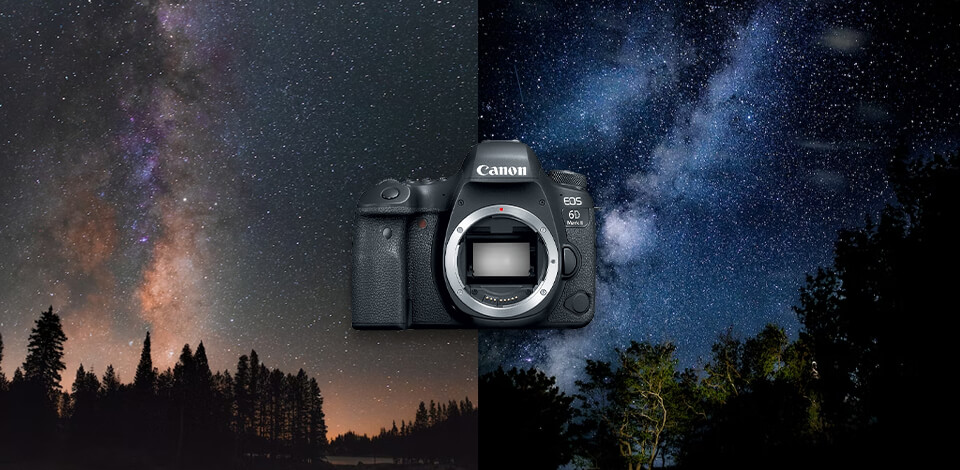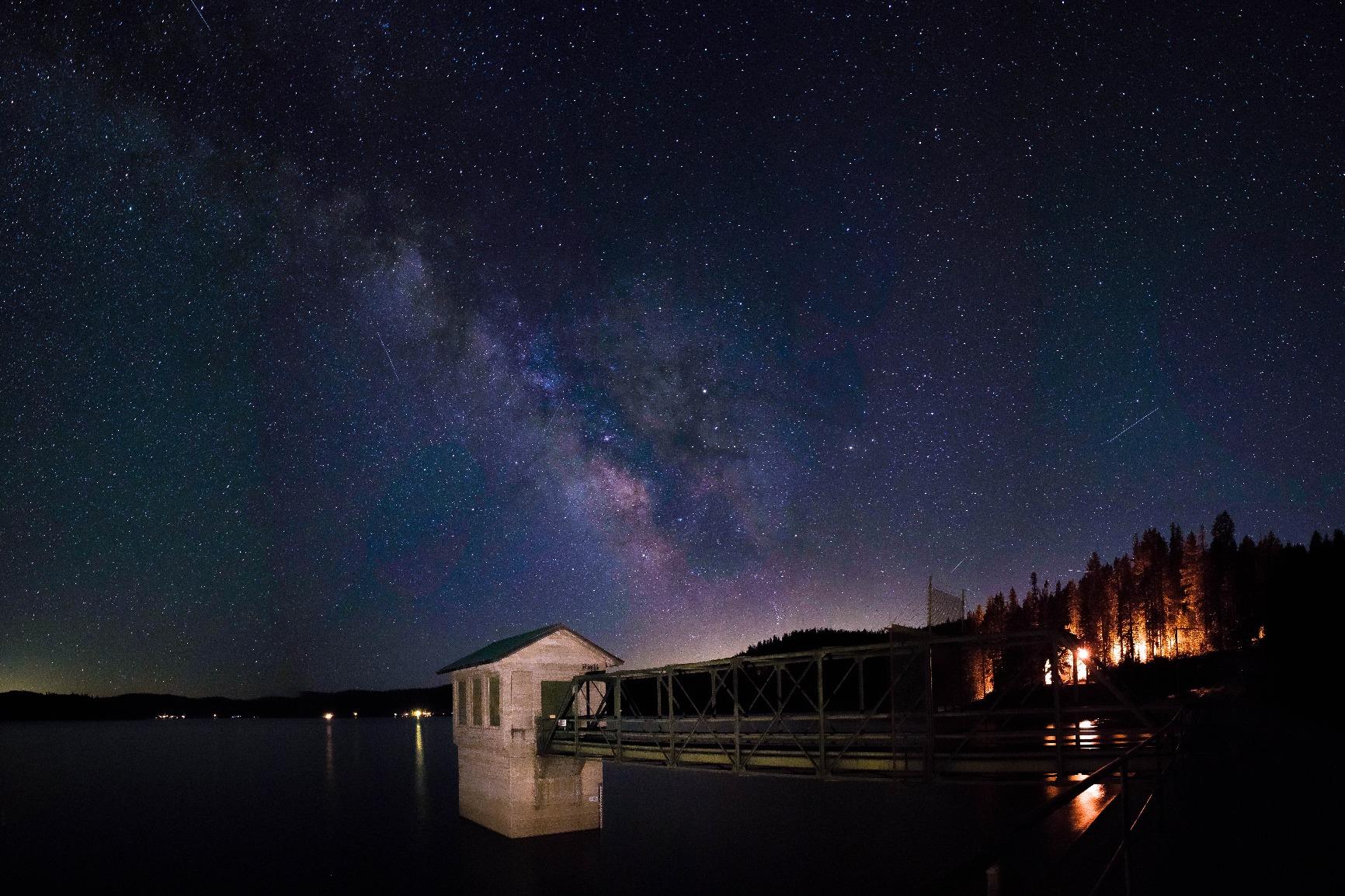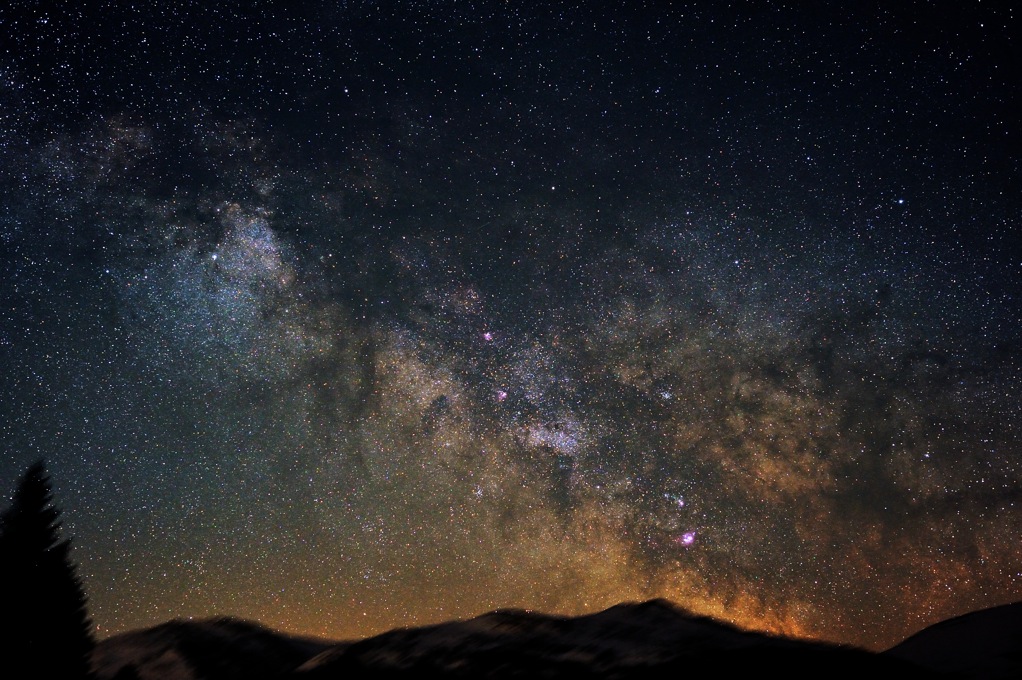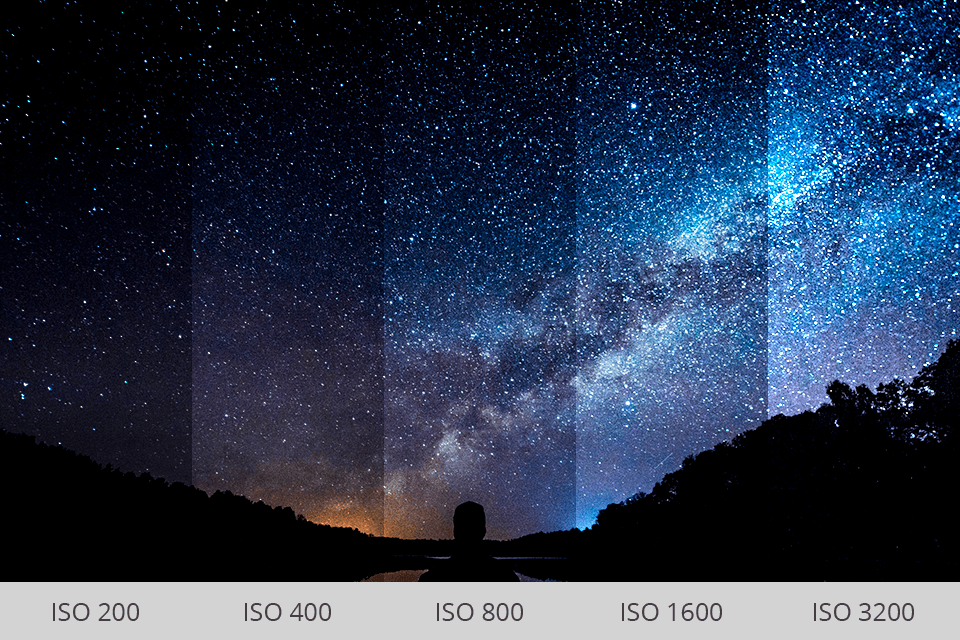
Not just any camera will do when it comes to astrophotography. You need the camera that offers excellent low-light performance and powerful image stabilization. It can be DSLR or mirrorless camera, or a dedicated astrophotography camera. Such models perfect for professionals to capture the Milky Way and planets. They can even record infrared images, expanding your astrophotography possibilities.
| IMAGE | NAME | FEATURES | |
|---|---|---|---|

|
Canon EOS Ra
FIRST CHOICE
|
CHECK PRICE → | |

|
ZWO ASI533MC Pro
FOR PROS
|
CHECK PRICE → | |

|
ZWO ASI183MC Pro
BUDGET
|
CHECK PRICE → | |

|
Canon Rebel T7i
ENTRY-LEVEL
|
CHECK PRICE → | |

|
Sony A7 III
FOR LOW-LIGHT
|
CHECK PRICE → | |

|
Nikon D3400
DURABLE
|
CHECK PRICE → | |

|
Fujifilm X-T5
VERSATILE
|
CHECK PRICE → | |

|
Nikon Z 6II
RUGGED
|
CHECK PRICE → | |

|
Nikon D850
TIMELAPSE
|
CHECK PRICE → |
As a beginner, you don't have to break the bank to get started in astrophotography. Remember to prioritize a large sensor and excellent ISO performance when choosing the camera for night photography. I also recommend to use wide-angle lens with a wide aperture to maximize brightness and clarity.

Type: Full Frame Mirrorless | Resolution: 30.3MP | ISO: Up to 40,000 | Magnification: 30x
The EOS Ra is a dedicated astrophotography camera with special sensor glass that allows more red light to reach the sensor. This results in capturing details of certain types of nebulae in a more vivid manner.

It also has an impressive autofocus system, providing fast and accurate initial focus when shooting at night. The dual-pixel CMOS autofocus technology ensures that the subject remains sharp and well-focused in any situation.
| Canon EOS Ra | Canon Rebel 450D (my old camera) | |
|---|---|---|
|
Camera Functionality |
Advanced |
Basic |
|
Low Light Performance |
Improved performance |
Limiting |
|
Autofocus |
Impressive and fast |
Wide area system |
|
Long Exposure Capability |
Reduce noise |
Higher noise levels |
|
Video |
✔️ |
❌ |
|
Image Quality |
High-level (30.3MP) |
Average (12.2MP) |
The Canon Rebel 450D was my first astrophotography camera, and ever since then, I've continuously utilized a DSLR camera each season. Over time, I've acquired close to five different cameras dedicated to astrophotography, the most recent addition being the Canon EOS Ra, a full-frame camera. I compared my first and my last camera's characteristics and photo quality when shooting at night.
For astrophotography, Canon Rebel 450D provided a stepping stone for beginners due to its ease of use and availability of accessories. However, compared to more specialized astrophotography cameras, it has limitations.

In my testing, Canon EOS Ra’s full-frame sensor and modified filter deliver improved performance in low-light conditions, reducing noise in long exposures.
In terms of functionality, the Canon EOS Ra's high-sensitivity capabilities, large dynamic range, and wide color spectrum allow for capturing more detail in shadows and highlights. This astrophotography camera also offers advanced features like HDR and tone mapping for precise control over exposures and colors. This camera is a more suitable choice for dedicated astrophotographers seeking enhanced performance in capturing the celestial wonders.

Type: Dedicated astronomy camera | Sensor type: 1 inch CMOS | Resolution: 9MP | Max FPS: 20fps
The large pixels of the ZWO ASI533MC Pro contribute to a high signal-to-noise ratio, which is crucial for deep-sky imaging. For planetary and lunar/solar imaging, the ZWO 'Pro' series is particularly well-suited, thanks to its larger color sensors that allow for capturing impressive 'one-shot' images.
A dedicated astronomy camera like the ZWO ASI533MC Pro can make a substantial difference in your astrophotography, especially for long exposures. Unlike DSLR cameras, dedicated astronomy cameras produce images in the FITS format, which requires specialized software for processing and stacking high-resolution individual subs.

Another fantastic feature of this camera that I liked is the ability to control it wirelessly through a phone or tablet using software like the free AstroCapture app. This allows for convenient focusing, capturing images, and even conducting plate solving and computerized mount control. It's a truly useful feature that can make a significant difference in capturing the perfect shot.

Type: Dedicated astronomy camera | Sensor type: CMOS | Resolution: 20.1MP | Max FPS: 19fps
The ZWO ASI183MC Pro is designed to cater to a wide range of imaging goals, whether you're capturing the Moon, Sun, planets, or deep sky objects.
This camera for astrophotography uses a back-illuminated CMOS sensor, specifically designed by Sony, which offers exceptional sensitivity and image quality. The sensor's high peak quantum efficiency (QE) ensures that a high percentage of the light hitting the sensor is utilized, resulting in remarkable ISO performance without noticeable image noise or oversaturation of stars.

Lastly, the ASI183MC Pro is equipped with a powerful Peltier cooler, capable of cooling the camera up to 45 degrees Celsius below the ambient temperature. This means you can use the camera in a wide range of environments, from cold to tropical, without worrying about overheating.

Type: DSLR | Resolution: 24.2MP | ISO: Up to 25600 | Magnification: 3x
The Canon Rebel T7i offers a high dynamic range, which allows you to recover underexposed areas of your images during post-production. This is really helpful when shooting those stunning nighttime scenes.
As for me, this astrophotography camera is a great choice for beginners, as it offers a balanced combination of features and performance. The built-in WiFi makes it easy to share your photos with friends and family, and the autofocus feature is fast and accurate, eliminating the need for manual focusing.

Additionally, this entry-level DSLR is capable of recording videos in 4K, which is a great bonus for those looking to capture stunning time-lapse footage.
The T7i has a rotatable screen that flips out, allowing you to see the image when the camera is pointed at unusual angles on a tracker or mount. The screen can also be dimmed to prevent image visibility when the camera is not in use.

Type: Full Frame Mirrorless | Resolution: 24.2MP | ISO: Up to 204,800 | Magnification: 0.78x
One of the biggest advantages of the Sony A7 III is its customization options. Almost every button and dial on the camera can be customized to your preferred function, which is a huge advantage when shooting astrophotography.
This Sony camera has great low-light capability and a wide dynamic range, allowing you to capture brighter stars and nebulae without the need for long exposures, reducing the risk of 'blown out' stars.

Another advantage of this camera for astrophotography is the ability to capture high-quality 4K video, which is a great feature for those who want to delve into videography. The built-in intervalometer and tilting screen are also handy for astrophotographers, as they allow for comfortable use when the camera is mounted on a tripod.

Type: DSLR | Resolution: 24.2MP | ISO: Up to 25,600 | Magnification: 11x
As an experienced photographer, I can say that the D3400 is a solid choice for capturing stunning night photography ideas. Its 24-megapixel sensor and excellent autofocus system make it a great camera for astrophotography. You'll be able to capture galaxies, star clusters, and nebulas with incredible detail.
One standout feature of the D3400 is its in-body image stabilization, which helps reduce vibrations and keeps your stars looking like points of light instead of squiggles. Just make sure to use a tripod for the best results.

The D3400 also comes with a new AF-P lens that offers faster and smoother focus performance in Live View mode. It's whisper quiet when focusing, making it ideal for video recording. However, it's worth noting that the camera lacks a body-based screw drive, meaning it won't work with older NIKKOR lenses.

Type: Mirrorless | Resolution: 40.2MP | ISO: Up to 12,800 | Magnification: 1x
I chose the Fujifilm X-T5 camera for this list because it does a fantastic job at capturing astrophotography shots. The high-resolution sensor, improved IBIS (in-body image stabilization), and video capabilities are worth mentioning features of this camera.
This camera for photography has good ISO performance and handles hydrogen alpha (Ha) exceptionally well. This is important for capturing those mesmerizing emission nebulas that glow in the infrared.

Its compact body is perfect for travel and backpack photography, and it's weather-sealed, so you can take it to almost any destination and capture stunning night images. Plus, the high number of manual dials for ISO, shutter speed, and aperture give you quick access to essential settings, eliminating the need for complicated menus.

Type: Full Frame Mirrorless | Resolution: 24.5MP | ISO: Up to 51,200 | Magnification: 1x
The Nikon Z 6II truly stands out in the crowded mirrorless market for capturing stunning astro and landscape shots. It offers exceptional image quality, even in low-light and high ISO settings. Plus, it has some added features that make it even better for long exposures.
One of the standout features of this camera for astrophotography is its large and clear touchscreen display. It makes it super easy to check and adjust settings on the go. Many astrophotographers even use the LCD to help get the white balance and image colors correct as they shoot.

In terms of advantages, the Z 6II offers an impressive AF system, and a built-in intervalometer, making it a top choice for nightscape photographers. Its small size and lightweight design also make it easy to carry around, even during long shooting sessions.

Type: DSLR | Resolution: 45.7MP | ISO: Up to 25,600 | Magnification: 0.75x
Overall, I must say the Nikon D850 is a fantastic choice for capturing the beauty of the night sky. One of the standout features of the D850 is its high-resolution sensor, which delivers exceptional detail in your images. This is crucial when it comes to astrophotography, as it allows you to capture even the tiniest details in the night sky.
The D850 also excels in its ease of use. It boasts backlit buttons and a tilting touchscreen, making it simple to navigate and operate even in the dark. This is a huge plus, as astrophotography often requires shooting in low-light conditions. Moreover, the camera's wide dynamic range ensures stunning details in astro-landscapes.

In addition, the D850 can record 4K video and has a high megapixel count, perfect for capturing high-resolution images of the night sky. The camera is also capable of shooting timelapses, which is ideal for capturing the movement of stars over an entire evening.
Depending on your interests, you'll need different lenses for capturing specific celestial wonders. Wide-angle lenses are great for capturing the Milky Way, while telephoto lenses are ideal for capturing those mesmerizing stars.

Canon RF 15-35mm f/2.8L IS USM. This wide-angle zoom lens is highly sought after by professional and serious amateur astrophotographers. The lens delivers sharp images, even when stopped down to f/4, and it has minimal distortion, which is particularly useful for astrophotography.
Canon EF 24-105mm f/4L. This zoom lens has the ability to produce sharp stars when shot at high magnifications. In my tests, even when aimed at bright stars and planets, the lens consistently delivered sharp results at f/8 and above.
Nikon AF-S 14-24mm f/2.8G ED. One of the standout features of this wide-angle lens is its ability to produce stunning sunstars when stopped down to around f/2.8. The lens also displays minimal coma and astigmatism, with the only significant distortion being barrel distortion at the short end of the zoom range.
Sigma 14-24mm f/2.8 DG HSM Art Lens. This Art-series zoom lens delivers sharp and crisp star points with good contrast, even in the corners. The Super Multi-Layer Coating effectively minimizes lens flare and ghosting, even when shooting in backlit conditions.
Rokinon 14mm F2.8. This lens allows you to capture vast sections of the night sky, including mountains and cityscapes, without any fisheye distortion. It's currently the widest full-frame rectilinear lens for astrophotography available for DSLRs.
When I started as an astrophotographer, I didn’t think about other accessories except lenses and cameras for astrophotography. But who those who want to take astrophotography to the next level and capture breathtaking images of the night sky, investing in some accessories will greatly enhance results.
One of the most important accessories is a solid tripod for astrophotography to ensure sharp and steady shots. This is crucial because any movement during long exposures can result in blurry images.
You also may need a telescope for astrophotography. When choosing it, it's crucial to consider the back focus compatibility with your camera and its ability to correct optical aberrations like coma and field curvature.
For more advanced astrophotography, such as capturing star trails or nebulas, a telescope mount and star tracker are essential. These accessories allow you to track the movement of celestial objects and compensate for the Earth's rotation during long-exposure shots.

When it comes to tracking mounts, an equatorial mount is highly recommended. This type of mount has two axes - one for east to west movement (right ascension) and one for north to south movement (declination).
To align the mount correctly, you need to center the second axis on Polaris, also known as the North Star, which is located in the constellation of the Plough or Big Dipper. This can be easily done using a polar alignment scope that helps you center Polaris accurately.
To achieve precise focus on a specific point in the night sky, especially with a wide-angle lens, a Bahtinov mask is a useful accessory. It is a piece of black plastic that fits over the camera lens, reducing the amount of light reaching the sensor. This allows you to achieve sharp focus on a specific point in the sky.
To improve the tracking accuracy of your mount, you can consider getting a guide scope and a guide camera. The guide camera takes short exposure images of the night sky and tracks the position of a "guidestar" placed near your target.
Having a variety of lens filters, such as neutral density, polarizer, hydrogen-alpha, and star soft filters, can greatly enhance the colors, contrast, and reduce the effects of light pollution and glare from street lights in your astrophotography.
Other important accessories to consider are a powerful battery for your camera, a power bank to keep your equipment charged during long shooting sessions, and a remote or intervalometer to control the camera shutter for longer-exposure shots. A finderscope can also be helpful for locating and framing your desired celestial objects accurately.
When choosing the camera type, remember that the DSLRs are known for their sturdiness and better low-light performance, while mirrorless camera are lighter and more compact. If you want to engage in astrophotography professionally, then you may need a dedicated astrophotography camera.

Sensor size. The larger the sensor, the more light it can absorb, making it easier to capture stunning images of the stars. Full frame sensors are generally larger and more sensitive to low-light conditions, which is perfect for astrophotography.
ISO performance. A high ISO capability will help you capture more details in low-light conditions. You should aim for a camera with a maximum ISO capability of at least 12,800.

Dynamic range. A camera with a high dynamic range can help you capture more details in the highlights and shadows of your images.
Manual settings. It's also important to choose a camera for astrophotography that has manual settings, as this will allow you to have full control over your exposure and other key settings.